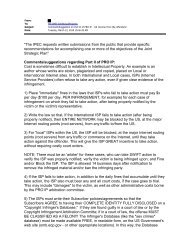We Energies Coal Combustion Products ... - The White House
We Energies Coal Combustion Products ... - The White House
We Energies Coal Combustion Products ... - The White House
Create successful ePaper yourself
Turn your PDF publications into a flip-book with our unique Google optimized e-Paper software.
<strong>The</strong> only other compounds detected that were within one order of magnitude<br />
of the category 2 criteria were antimony, barium, chromium and sulfate. <strong>The</strong><br />
remaining elements were either non-detectable or were several orders of<br />
magnitude below the category 2 criteria.<br />
<strong>The</strong> first 10,000 tons of recovered ash was used as a sub-base material under<br />
pavements. This practice has continued due to the excellent sub-base and base<br />
performance of the interlocking angular shaped recovered ash particles for this<br />
application. This is an application meeting NR538.10 (5) category 4<br />
standards. However the recovered ash test results meet most of the NR 538<br />
category 2 requirements.<br />
In February 2001, Wisconsin DNR and <strong>We</strong> <strong>Energies</strong> entered into an<br />
agreement in which an ash sampling and testing procedure was specified. In<br />
order to determine the chemical consistency of the coal combustion materials<br />
recovered from the landfill, the ash will be excavated, processed, and stored in<br />
a designated area in the landfill in no larger than 50,000 cubic yard piles. A<br />
representative sample will be obtained per each 10,000 tons of reclaimed<br />
material for testing using guidelines presented in ASTM D2234. A minimum<br />
of five discrete samples of at least 25 pounds each will be collected from<br />
different locations on the storage pile. <strong>The</strong>se discrete samples will be<br />
composited, mixed, and volume reduced by manual riffling to develop the<br />
analysis sample. Testing will be performed to measure category 2 parameters<br />
(described in ch. NR 538, Wis. Adm. Code), as well as boron as an additional<br />
leachable parameter, for use as sand/gravel/and crushed stone replacement<br />
materials. <strong>The</strong>se recovered materials will be used in category 4 or 5<br />
applications (described in ch. NR 538, Wis. Adm. Code).<br />
Reburning of <strong>Coal</strong> Ash (U.S. Patent # 5,992,336) (51)<br />
If coal ash has a significant amount of unburned carbon, it cannot be utilized<br />
directly in applications such as concrete, and concrete products. According to<br />
ASTM C618, an ash must have a LOI value no higher than 6% for use in<br />
concrete. An upper limit of 3% is more realistic. Higher LOI ash cannot be<br />
used because of color problems and concerns for durability under freezing and<br />
thawing conditions.<br />
<strong>We</strong> <strong>Energies</strong> is utilizing an innovative technique, reburning of coal ash, to<br />
treat high carbon coal ash using existing capital installations, and particularly<br />
the existing pulverized coal boilers. <strong>Coal</strong> ash, either fly ash or bottom ash or a<br />
mixture of both, is added in a fine particle condition to the furnace of a<br />
pulverized coal boiler in a small proportion to the pulverized coal fed to the<br />
furnace. <strong>The</strong> ash is burned with the pulverized coal. <strong>The</strong> proportion of coal<br />
ash is preferably in the range of 1% – 3.5%, by weight of the pulverized coal.<br />
<strong>The</strong> high carbon coal ash generally results from burning bituminous coal<br />
while sub-bituminous coal will typically result in a low carbon ash with an<br />
LOI of less than 1%. <strong>The</strong> high LOI fly ash and bottom ash formed from a<br />
177 <strong>We</strong> <strong>Energies</strong><br />
<strong>Coal</strong> <strong>Combustion</strong> <strong>Products</strong><br />
Utilization Handbook



